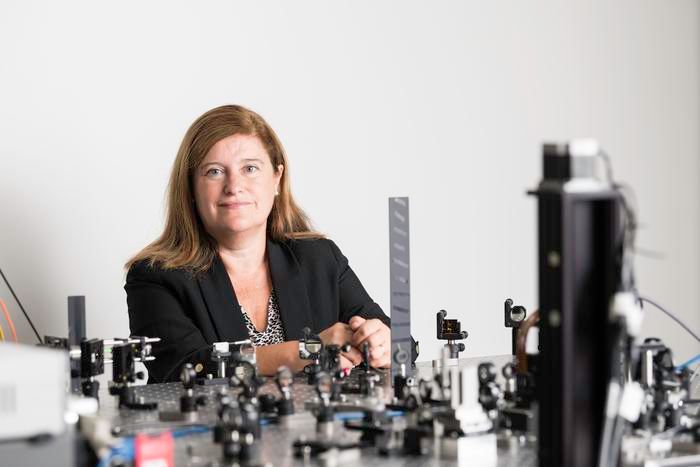News
Article
AI offers clarity to LASIK patients facing cataract surgery
Author(s):
A team of University of Rochester scientists develop computer models of patients’ eyes to identify the ideal IOLs and visual simulators for patients to experience how they will see with them.
Susana Marcos, the David R. Williams Director of the Center for Visual Science and the Nicholas George Professor of Optics and of Ophthalmology, says the computational simulations developed by Rochester researchers provide surgeons with important guidance on the expected optical quality for LASIK patients after cataract surgery. (Image courtesy of University of Rochester/J. Adam Fenst)

While millions of people have undergone LASIK eye surgery since it became commercially available in 1989, patients sometimes develop cataracts later in life and require new corrective lenses to be implanted in their eyes. With an increasing number of intraocular lens options becoming available, scientists have developed computational simulations to help patients and surgeons see the best options.
According to a study,1 a team of University of Rochester researchers developed computational eye models that included the corneas of post-LASIK surgery patients and studied how standard intraocular lenses and lenses designed to increase depth of focus performed in operated eyes.
According to a University of Rochester news release, Susana Marcos, the David R. Williams Director of the Center for Visual Science and the Nicholas George Professor of Optics and of Ophthalmology at Rochester, pointed out the computational models that use anatomical information of the patient’s eye provide surgeons with important guidance on the expected optical quality post-operatively.
Marcos, a co-author of the study, noted in the news release the only pre-operative data used to select the lens is essentially the length and curvature of the cornea.
“This new technology allows us to reconstruct the eye in three dimensions, providing us the entire topography of the cornea and crystalline lens, where the intraocular lens is implanted,” Marcos said in the news release. “When you have all this three-dimensional information, you’re in a much better position to select the lens that will produce the best image at the retinal plane.”
The future of OCT
Marcos and her collaborators from the Center for Visual Science, as well as Rochester’s Flaum Eye Institute and Goergen Institute for Data Science, are conducting a larger study to quantify in three dimensions the eye images using the optical coherence tomography quantification tools they’ve developed to find broader trends. They are using machine-learning algorithms to find relationships between pre- and post-operation data, providing parameters that can inform the best outcomes.
Moreover, the researchers have Additionally, they have developed technology that can help patients see for themselves what different lens options will look like.
“What we see is not strictly the image that is project on the retina,” Marcos said in the news release. “There is all the visual processing and perception that comes in. When surgeons are planning the surgery, it is very difficult for them to convey to the patients how they are going to see. A computational, personalized eye model tells which lens is the best fit for the patient’s eye anatomy, but patients want to see for themselves.”
With an optical bench, the researchers use a technology created for astronomy, including adaptive optics mirrors and spatial light modulators, to manipulate the optics of the eye as an intraocular lens would.
Marcos explained in the news release the approach allows the research team to perform fundamental experiments and collaborate with industry partners to test new products. Marcos also helped develop a commercial headset version of the instrumentation called SimVis Gekko that allows patients to see the world around them as if they had had the surgery.
The university concluded in its news release the researchers also are applying their methods to study other major eye conditions, including presbyopia and myopia.
Reference:
Carmen M. Lago, PhD, Alberto de Castro, PhD, Susana Marcos, PhD. Computational simulation of the optical performance of an extended depth of focus intraocular lens in post-LASIK eyes. Journal of Cataract and Refractive Surgery. Published July 17, 2023. Accessed September 26, 2023. DOI: 10.1097/j.jcrs.0000000000001260.
Newsletter
Don’t miss out—get Ophthalmology Times updates on the latest clinical advancements and expert interviews, straight to your inbox.





